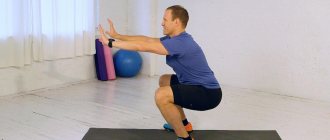Barbell squats require not only muscle strength, but also good flexibility, coordination, and dexterity. The movement is used in all sports. In fitness, they study a variant of it that prevents progress in strength in the future. We are talking about a “parallel squat” with knees pointing forward and a strongly inclined back. Why do they teach this? This is exactly what makes it easier for the instructor; there is no need to work on the client’s flexibility, think about which muscles are lagging behind, and write a balanced clan. In a fitness club, a person is simply put under a barbell, forced to perform a more or less similar movement, and he progresses to the numbers he can. Next begins the story about pumping up muscles with light weights. So a person “pumps”, attending classes for years and complaining about unsuccessful genetics. In fact, it is enough to correct technical errors, make the movement natural, and strengthen weak links for the squat to grow.
Why is this exercise needed?
Legs are our foundation, no matter what sport we play. Boxing, wrestling, crossfit, powerlifting, fitness - you will not achieve significant success in any of these disciplines if your legs do not receive sufficient load as part of your training process.
The barbell squat is perhaps the heaviest exercise of all. And not only physically, but also mentally. Watch any powerlifting competition and notice how the lifters prepare themselves before their squat attempts. It is unlikely that you will want to get in the way of this person. Only in a state of crazy courage can you conquer such inhuman weights.
We’ve sorted out powerlifting, where the squat is a competitive movement. What is the role of squats in CrossFit:
- Squats with a barbell on the shoulders are part of many complexes for athletes of different levels of training.
- Without a technically correct squat, you can forget about movements such as the snatch, clean and jerk, thrusters, cleans, etc.
- The squat is one of those exercises that ramps up the intensity and pace of your workout. Performing really heavy squats requires enormous energy expenditure, emotional state and motivation, significantly increasing the heart rate, which contributes to the process of lipolysis.
Main types of squats
There are several main types of squats. They require compliance with certain rules in order to achieve the desired goal. Let us introduce you to how to take the starting position and perform the exercise:
Squats for beginners. Beginners can use chair squats. Take a standard starting position. During the execution, use a chair at the moment when your torso becomes parallel to the floor, you sit down on the chair.
squats on a chair
Wall squats. If you have good physical fitness and have mastered the basic exercises with a barbell, you can try wall squats. Take your starting position - your feet are shoulder-width apart, your back is leaning against the wall, and you are holding a plate in your hands, which you need to press to your chest. When you squat, hold for a few seconds until your thighs are parallel to the floor. With a fairly heavy load and maintaining the tempo of the exercise, you will have all the load on the anterior thigh muscle.
Wall Squats
Barbell squats with narrow feet. This is the same exercise as the classic squat. The starting position will be similar. The main difference is in the position of the legs, i.e. in the classics it is shoulder-width apart, but here, as you understand, the position of the legs is narrow. When performing the exercise, place most of the load on the anterior thigh muscle, while the posterior one will play a supporting role. Due to the fact that the position of the legs is narrow, the movement will not work at full amplitude, i.e. It will not be possible to sit down to the floor, and that is why the back of the thigh will not receive the load that it receives in a classic squat.
Barbell squats with narrow feet
Smith squats. The technique of squats in the Smith machine is very similar to regular squats, but there are significant differences. To begin, you need to set the bar at a comfortable height for you (it should be such that the bar is located just below your shoulders). Next, you sit under the bar, take it with an overhand grip and straighten up. Place your feet slightly wider than your shoulders and 20-25 cm further than your hips. The pelvis is pulled back, the back should be strictly perpendicular to the floor. Take a deep breath and sit down, moving your pelvis back. You need to sit just below parallel. As you exhale, push yourself up using only the strength of your legs and buttocks.
Smith Squats
Attention! When performing, you need to look straight ahead and maintain the natural deflection of the spine.
Front squats with a barbell. Take the standard starting position. The bar will not be at the back, but on the front deltoid. To perform such squats you need to have some experience. This exercise works the abdominal, thigh, calf, and gluteal muscles. The load on the back and the possibility of knee injury are reduced. You do not lean forward, and the lumbar region does not strain. While performing the exercise, look straight ahead. The starting position will be standard, the only difference is the location of the bar. Elbows are forward. Squat slowly, while your chest should go to the front. You choose the depth of the squat yourself. Start the upward movement from the chest, without helping yourself with your elbows, raising them even higher.
Front squats with barbell
What muscles work?
The main dynamic load falls on:
- Quadriceps;
- Biceps femoris;
- Adductor muscles of the thigh;
- Gluteal muscles;
- Spinal extensors.
The abdominal muscles, gastrocnemius, soleus and trapezius muscles act as stabilizer muscles throughout the movement.
Tips and common mistakes
The effectiveness of any exercise depends on its correct execution.
First of all, you need to prepare properly. The bar must be removed from the rack correctly. It is better to bring your shoulder blades together and squeeze it with your hands very tightly, while taking a deep breath and taking two steps back. Elbows should be directed towards the floor, chin pointing towards the chest, take another breath and begin to squat smoothly.
It is necessary to use the correct pelvic delivery. Make sure that when squatting, your hips go back a little faster than your knees. This will reduce possible pain in the knees. Try to load the gluteal muscles and tendons that are located under the knee. This will allow you to do deep squats.
One of the most common mistakes is squatting shallowly. Unless you have a leg or knee injury, be sure to maintain the correct squat depth. The front of the thigh should be below the height of the kneecap. When asked to do a partial squat, the depth can be reduced, but you don't have to do it all the time. You will not be able to achieve your goal to the required extent.
Pros and cons of barbell squats
The barbell squat is a basic compound exercise that works almost every major muscle group in your body. It is unlikely that any exercise other than the deadlift can compare with squats in this regard. This kind of load cannot but lead to results: you become stronger, more resilient and more muscular.
Benefits of exercise
For men, heavy squats are the #1 exercise. Numerous studies prove the hypothesis that performing this exercise leads to increased secretion of the main anabolic hormone - testosterone. It is this hormone that is responsible for all the traits inherent in a real man: physical strength and endurance, self-confidence, consistently high sexual energy, cheerful well-being, as well as what is commonly called “male charisma.” For this reason, we recommend that all men, regardless of age, perform barbell squats, unless there are medical contraindications.
Start with small working weights and gradually add discs to the barbell, then over time you will see that you have not only made serious progress in your workouts in the gym, but also generally feel more confident and energetic.
However, all this does not mean that squats are a purely masculine exercise. For girls, barbell squats should also become one of the foundations of the training process. It is this movement that puts the most stress on the hips and glutes and gives them an athletic shape.
In addition, intensive squats involve a fairly serious expenditure of energy. A few really hard sets will burn more calories than walking on a treadmill for half an hour. Therefore, squats should be performed not only if your goal is to slightly pump up your legs and buttocks, but also during the period of getting rid of excess fat, so the drying process will be much more efficient.
Possible harm from exercise
All potential harm from barbell squats comes down to the consequences caused by poor technique. A strong deviation from the correct technique or working with critically heavy weights can lead to injuries to the knee ligaments and joints, as well as the occurrence of protrusions and hernias in the lumbar spine. Injuries to the shoulder joints and rotator cuff are also not uncommon. As a rule, they arise as a result of incorrect (too low) position of the barbell.
It is also believed that barbell squats lead to one unpleasant side effect - an increase in waist size. This is not entirely true, because your waist size is determined by genetics, the tendency of the obliques to hypertrophy, and the volume of your stomach. However, the load on the obliques and abs during squats is really serious, and if you value your waist and feel that it is starting to grow, then it is better to slow down with heavy weights in squats and deadlifts. Squats also increase intra-abdominal pressure, which can lead to the formation of an umbilical hernia, but in most cases this problem can be avoided by using an athletic belt.
Contraindications
During squats with a barbell, a strong axial load is created on the spine, so this exercise is strictly contraindicated for all athletes who have any problems with the musculoskeletal system. The same goes for knee or hip joints: if you have had injuries in the recent past, then performing barbell squats should be kept to a minimum. For rehabilitation and restoration of injured tissues, it is better to use isolated exercises, for example, bending and extending the legs in a machine.
Strengthen your back
The spinal column is your “gearbox”, which allows you to use the maximum amount of energy when squats. The lumbar erector muscles are perhaps the most important muscle group for building a strong core and allowing you to safely perform a variety of exercises.
Strengthen your back muscles with deadlifts, hip stretches and a special “good morning” exercise (translated as “good morning” and is a series of exercises aimed at flexing and extending the back with a special weight placed on the neck). Additionally, work on strengthening your upper back muscles by doing barbell rows and pull-ups.
Execution technique
There are many hypotheses regarding the correct technique for squats with a barbell on the shoulders. Their number is due to the fact that the technique can vary due to the anatomical characteristics of a particular person (for example, the length of the limbs, the volume of the buttocks, flexibility in the hip and shoulder joints, etc.). Therefore, the recommendations listed below are of a general nature only; a competent personal trainer can help you develop a more acceptable technique. Well, let's figure out how to do a barbell squat correctly.
Taking the barbell on your back
The first phase of the movement is to remove the barbell from the racks. Grasping the bar tightly at a width slightly wider than your shoulders, we sit under the bar exactly in the center of the bar, pressing into the bar with our trapezoids, and remove the bar with the movement of our legs. It is extremely important to keep your back straight when removing the bar from the racks, since it is at this moment that our spine experiences maximum axial load.
The next phase is to move away from the posts and secure yourself. You need to take a few steps backwards, find a stable, stable position and begin the exercise. Take your time when you step backwards; your movements should be smooth and confident. Otherwise, you will lose balance and control of movement, thereby risking injury.
Squat
Increase your elasticity
Squat below the parallel point of your pelvis and knees, but use different stances and bar placement. For example, I’ll try a high position of the bar lying on the trapezium and at the same time a narrower stance in the legs. This rack is also good for weightlifting. Then try a wider stance while placing the barbell lower on your shoulders. This type of squat works more on the hips and back. You will see for yourself that using different positions uses different muscle groups and requires completely different types of flexibility from you.
How to increase your barbell squat?
Every second gym goer wonders how to increase a barbell squat. There are many methods, but the point is always in two aspects: proper cycling of loads (using percentages and alternating light/heavy training) and performing auxiliary exercises. In practice, a competitive powerlifter will typically do two squat workouts per week, one with a weight equal to 50-60% of the maximum for 5 reps for three sets, and the other with a weight equal to 75-85% of the maximum. maximum, 5 repetitions in five approaches. Closer to the competition, the weight of the bar increases, and the number of repetitions decreases.
When it comes to accessory exercises, the most commonly preferred exercises are pause squats, front squats, barbell bend-overs, bench squats, and overhead squats.
- Pause squats are a type of squat in which the athlete works at the deepest possible amplitude, fixating for a few seconds at the lowest point. The upward movement is explosive in nature, thereby significantly increasing the speed of the lift during normal squats.
- Front squats differ from classic squats with a barbell in the position of the bar - here it is on the chest. Thanks to this, the vector of movement changes slightly, and the quadriceps receives a more serious load.
- Bent-overs are extremely important for strength athletes because they help keep your core more stable during heavy squats.
- Bench squats are a type of squats with a shorter amplitude (we lower ourselves above parallel), where our task is to lower ourselves to the level of the bench.
- Overhead squats are a coordination exercise that are quite challenging for beginners. Helps you get a better feel for corners and blind spots.
Front Squat Variations
Front squats can be performed not only with a barbell, but also with dumbbells or kettlebells, as well as in a Smith machine.
Option with dumbbells and kettlebells
The front squat with dumbbells or kettlebells is often used by beginners or girls, as these equipment are considered safer for use in this exercise.
With dumbbells
With weights
Read about how to do squats with dumbbells → About squats with a kettlebell in this article →
Variant in Smith's machine
Among the main advantages of the front squat in the Smith machine are safety, which in turn indicates a reduced risk of injury, as well as less load on the spine and knee joints, thanks to which the athlete can fully concentrate on working out the target muscle group. In addition, the Smith front squat helps you understand the technique of this exercise and then transfer it to working with free weights.
Perhaps the only serious drawback of front squats in the Smith machine is the lack of load on the stabilizer muscles. The Smith machine is designed in such a way that the bar moves along a given vertical path, and the athlete does not have to hold it in space. On the one hand, this is a plus, since you can completely focus on working out the target muscles, as mentioned earlier, but on the other hand, the stabilizer muscles also need to be given enough attention, so it is recommended to alternate work in the Smith machine and with free weights .
Common mistakes
If doing squats doesn't give you the results you want, you're doing something wrong. Below is a short list of the most common mistakes that are common to most novice athletes:
Incorrect range of motion
Only deep squats give a truly serious effect. If you don't even go down to parallel level with the floor, then don't expect results. At the lowest point, the back of the thigh should touch the calf muscles. Not all athletes succeed in this immediately due to weak stretching, so do not forget to stretch after training, special attention should be paid to the quadriceps and adductor muscles of the thigh.
Rounding the back while lifting
This can be seen in every gym when an athlete squats with maximum weight. If your back is not strong enough to stay straight during heavy squats, then you should lower the weight a little and start training your spinal extensors. Hyperextensions with additional weights are best suited for this. Using an athletic belt also partially solves this problem.
Movement in the lumbosacral spine
You may have seen more than once how some athletes “peck” their tailbone at the lowest point of the amplitude. This makes lifting a little easier, but under no circumstances should you do this - this is a direct path to injury.
Movement in the knee joint
Throughout the entire exercise, your knees should be in the same plane as your feet. Movement of the knees inward relative to the proper trajectory is unacceptable. A meniscus injury can put an end to your sports career.
Incorrect foot position
The feet should be slightly turned out and slightly wider than shoulder level. This is the only way you can sit deep enough without creating a strong load on the knee joint.
Incorrect breathing technique
Remember one simple rule: exhalation is always done with effort. Therefore, you need to inhale while going down, exhale while going up. If you do not follow this technique, your muscles will not receive enough oxygen and the effectiveness of the exercise will be greatly reduced. Deterioration in health, headache, nausea and fainting are also possible as a result of insufficient cerebral blood supply and increased intracranial pressure.
Squats in bodybuilding
In bodybuilding, the maximum weight of the barbell is not so important. The time the muscle is under force load has a much greater impact on the result, which leads to subsequent hypertrophy of the fibers.
Technique
Straighten your shoulder girdle, bend your lumbar region, keep your head level. Maintain this back position until the end of the approach:
- Grab the bar with a comfortable grip and step under the bar. Then straighten up and press the top of your shoulder blades against the barbell.
- After removing the load from the racks, step back.
- Place your feet at shoulder level or slightly wider, and point your toes out to the sides (45°).
- Inhaling air, smoothly move your pelvis back and at the same time bend your knee joints.
- Lower yourself until a right angle is formed between your shin and thigh, then exhale and return to the vertical position.
Technique Tips:
- Do not “fall” forward with your body. Otherwise, you risk hurting your knees or falling.
- Don't bring your hips inward. Such an error can lead to damage to the ligaments of the knee joints.
- Monitor both phases of the exercise. A smooth squat and an equally smooth rise.
- Keep your center of gravity in the middle. If you shift your body weight forward onto your toes, there is a risk of injury to your knee joints.
Reasons for poor squat performance
Typically this is:
- Incorrect execution technique, shifting the payload from the lower body to the back muscles.
- Overexertion of the legs in beginners, resulting from a combination of strength and aerobic types of training.
- The weight of the barbell is too light, which cannot create the necessary load for the muscles of the lower body.
Ways to improve your squat performance
Recommendations:
- Use proper technique. Have an experienced athlete watch your squats and note any mistakes.
- Add a “back room” to the program. For example, do power lunges, leg extensions, or farmer's walks.
- Select the correct barbell weight. At the end of each set you should feel failure set in.
- Use sports nutrition. Creatine, protein, vitamins will help build muscle size and strength.
- Use weightlifting accessories - belts and bandages. This will allow you to increase the weight of the barbell in squats.
- Perform 3-4 sets of 8-12 repetitions. This amount of training is considered optimal for enlarging legs.
- Try different variations of squats: front squats, Smith machine, narrow/wide leg squats, Hackenschmidt squats, etc.
- Increase the load with each workout. This will not allow the leg muscles to adapt and will contribute to their constant growth.
- Lighten the weight and try doing full-range squats. That is, do not lower your pelvis below your knees, and at the top point do not straighten your legs completely. At the same time, increase the number of repetitions to 25–30 per set.
Interesting fact. Six-time Mr. Olympia Dorian Yates said he was disappointed with squats as a mass-gaining exercise. The famous athlete completely abandoned this basic exercise and replaced it with a leg press in the simulator.
He explained this by saying that when certain weight loads are reached in squats, the risk of injuring the knees or spine increases critically. Therefore, for athletes training with weights over 200 kg, Yates recommends moving to the platform press.
Note that this advice applies only to experienced bodybuilders. For beginners, squats remain the best exercise for developing muscle mass throughout the body.
Standards for squatting without equipment
Unfortunately, the federal budget of our country is not enough to promote the development of powerlifting, so we have only one federation officially accredited by the State Sports Committee of the Russian Federation - the Russian Powerlifting Federation (RFP).
The standard is assigned based on the sum of three movements (squats, bench press, deadlift). There is no separate test for squats. If you want to truly test your strength, I highly recommend taking part in competitions. Competitions are regularly held throughout the Russian Federation; the competition calendar and regulations can be found on the official website of the federation.
There are also more than ten non-state federations operating on a commercial basis. The main funding comes from private investors, advertising of thematic products (sports nutrition, clothing and equipment) and entry fees from competition participants. The most popular non-state federation is WPC/AWPC (without doping control/with doping control). Below are their raw powerlifting standards for 2020.
AWPC-Russia category standards for bare powerlifting for men:
| Weight category | Elite | MSMK | MS | KMS | I category | II category | III category | I junior | II junior |
| 52 | 490 | 432.5 | 377.5 | 340 | 302.5 | 265 | 227.5 | 187.5 | 150 |
| 56 | 532.5 | 470 | 410 | 367.5 | 327.5 | 287.5 | 245 | 205 | 162,5 |
| 60 | 570 | 505 | 440 | 395 | 350 | 307.5 | 262.5 | 220 | 175 |
| 67,5 | 635 | 562.5 | 490 | 440 | 392.5 | 342.5 | 292.5 | 245 | 195 |
| 75 | 692.5 | 612.5 | 532.5 | 480 | 425 | 372.5 | 320 | 265 | 212,5 |
| 82,5 | 737.5 | 652.5 | 567.5 | 510 | 455 | 397.5 | 340 | 285 | 227,5 |
| 90 | 777.5 | 687.5 | 597.5 | 537.5 | 477.5 | 417.5 | 357.5 | 297.5 | 240 |
| 100 | 817.5 | 725 | 630 | 567.5 | 502.5 | 440 | 377.5 | 315 | 252.5 |
| 110 | 852.5 | 752.5 | 655 | 590 | 525 | 457.5 | 392.5 | 327.5 | 262.5 |
| 125 | 890 | 787.5 | 685 | 617.5 | 547.5 | 480 | 410 | 342.5 | 275 |
| 140 | 920 | 812.5 | 707.5 | 635 | 565 | 495 | 425 | 352.5 | 282.5 |
| 140+ | 940 | 832.5 | 725 | 652.5 | 580 | 507.5 | 435 | 362.5 | 290 |
For women:
| Weight category | Elite | MSMK | MS | KMS | I category | II category | III category | I junior | II junior |
| 44 | 287.5 | 255 | 222.5 | 200 | 177.5 | 155 | 132.5 | 110 | 90 |
| 48 | 317.5 | 282.5 | 245 | 220 | 195 | 172.5 | 147.5 | 122.5 | 97,5 |
| 52 | 345 | 305 | 265 | 240 | 212.5 | 185 | 160 | 132.5 | 107,5 |
| 56 | 372.5 | 327.5 | 285 | 257.5 | 227.5 | 200 | 172.5 | 142.5 | 115 |
| 60 | 395 | 350 | 302.5 | 272.5 | 242.5 | 212.5 | 182.5 | 152.5 | 122.5 |
| 67,5 | 432.5 | 382.5 | 332.5 | 300 | 265 | 232.5 | 200 | 165 | 132.5 |
| 75 | 462.5 | 410 | 355 | 320 | 285 | 250 | 212.5 | 177.5 | 142.5 |
| 82,5 | 487.5 | 432.5 | 375 | 337.5 | 300 | 262.5 | 225 | 187.5 | 150 |
| 90 | 507.5 | 450 | 390 | 352.5 | 312.5 | 272.5 | 235 | 195 | 157,5 |
| 90+ | 520 | 460 | 400 | 360 | 320 | 280 | 240 | 200 | 160 |
Types of lunges with a barbell on the shoulders and execution technique
You still have the barbell on your shoulders - only now it is not limited by anything, so part of your strength will have to be spent on keeping your body upright and maintaining balance. That is, the exercise turns out to be more energy-intensive - you spend more calories per unit of time due to the use of large muscle masses, more functional, because the deep muscles of the body are very actively involved, but more traumatic - accordingly, before moving on to serious weights in lunges with a barbell on the shoulders , you need to master the technique of performing this exercise with little or no weights.
As for the “direction” of lunges, you can do them forward, backward, to the side, and there are two options for stepping to the side - a cross lunge and a simple lunge to the side.
The difference here is the emphasis on the muscles of the lower limb girdle. Let's take it in order.
Classic lunges
Starting position: standing, the bar lies on the shoulders, in the projection of the rear deltoids and is firmly held by the hands. The correct grip width is unlikely to exist here - just like in the classic squat, here everyone determines for himself, depending on anthropometry. The main thing is that the barbell is firmly fixed and does not have a tendency to move off the shoulders. The shoulders are turned, the lower back is arched and fixed.
Keeping the body perpendicular to the floor, the knee of the working leg is brought forward, we take a wide step forward, after which both knees bend to an angle of 90 degrees . In this case, the knee of the working leg seems to be brought forward in front of you, the knee of the supporting leg touches the floor, or does not reach it literally a few millimeters. The working leg rests on the entire surface of the foot, the supporting leg stands on the toes turned away from itself. Next, with a powerful combined effort of the buttocks and quadriceps, mostly the working leg, we straighten up.
Your further actions depend on whether you are doing walking lunges or standing lunges:
- if you decide to lunge on the spot, place the working leg next to the supporting leg; a movement similar to the one described above is performed for the limb that was the supporting leg;
- in the step version, on the contrary, the supporting leg steps towards the working leg, then the exercise is performed with the leg that was previously the supporting leg;
- There is also a third option, when you do not change the position of your legs, perform a given number of lunges with your working leg, without changing its position relative to the supporting leg. This option is good for those who have just started learning lunges with a barbell on their shoulders.
These are, so to speak, general aspects of technology, but, as they say, “the devil is in the details.” Actually, depending on how you do lunges, different muscle groups are involved. The thing here is that the exercise in question is multi-joint, i.e. simultaneously, locomotion occurs in several joints: hip, knee, ankle.
It’s unlikely that anyone would think of developing the lower leg muscles with lunges, but it’s worth talking about the muscles of the thigh and buttocks:
- The function of the quadriceps is to extend the knee joint (primarily) and flex the hip joint (together with the iliopsoas muscle).
- The function of the gluteus maximus muscle is hip extension.
- Between them lies a group of muscles representing the back of the thigh - biceps femoris, semimembranosus, semitendinosus muscles. The most significant of them for us is the femoral biceps - so, its function is dual - on the one hand, it flexes the knee joint, on the other, it extends the hip joint.
Accordingly, when doing lunges, you can focus on each of the listed muscles, depending on what you would like to achieve:
- The emphasis on the muscles of the back of the thigh and buttocks shifts when taking the widest possible step. When the range of motion in the hip joint is maximum, and the knee joint bends less than 90 degrees, the main work is done by the hip extensors.
- The emphasis on the quadriceps will shift if the steps are relatively short and the knee of the working leg bends to an angle significantly greater than 90 degrees. To further challenge the quadriceps, it's a good idea to move your torso forward slightly (while maintaining an arch in your lower back);
- In order to load the gluteal muscles (in this case, the gluteus maximus muscles) as much as possible, the following technique will be required: the step with the working leg is performed as far forward as possible, the supporting leg is straightened and stretched almost parallel to the floor. The angle of flexion at the knee joint is maximum. You may say, how is it possible, this is how we engage the quadriceps to the fullest extent? This is partly true, but such an angle of knee flexion simultaneously provides the maximum possible angle of flexion in the hip joint and creates the necessary initial stretch in the gluteus maximus muscle, which allows it to be put into work as powerfully as possible.
Back lunges
The starting position is the same as in forward lunges. The supporting leg takes a step back, simultaneously bending the knee joints occurs in both limbs, the body is held in a stationary position, and a squat is performed until the knee of the supporting leg touches the floor. Taking into account the anatomical features outlined above, you can also play with the distribution of the load in this exercise.
A short video demonstrating how to perform backward lunges with a barbell:
Side Lunges
The starting position is the same. The working leg is abducted as wide as possible to the side, then the same leg is bent at the knee joint, while simultaneously moving the pelvis back. The knee bends to an angle of 90-100 degrees, after which the reverse movement begins. Upon achieving full extension in the knee and hip joints, you can either place the supporting leg to the working leg and proceed to perform the next repetition with the working leg, or with the supporting leg - a step option, or remain in the position where the heels are as far apart as possible from each other and, again, perform a given number of lunges with each leg.
In this option, the load is evenly distributed between the quadriceps and the adductor muscles of the thigh. Anticipating questions from the male part of the population, in the style of why do I need adductor muscles, I’ll say right away: regular work with the adductor muscles of the thigh will help fight the phenomena of stagnation in the pelvic floor organs , in simple terms - it will increase blood supply to the prostate and testicles and will prevent prostatitis and impotence in older people age.
Side cross lunges
The starting position is similar to the previously described options. The step with the supporting leg is made behind the back and to the side, so that the knee joint is in the projection of the heel of the working leg. The essence of this option is as follows: when getting up from a squat, you not only extend your hip joint, but also perform abduction in it, which allows you to use the gluteal medius muscles , the same ones that, with proper development, form the “finished” appearance of a woman’s butt.” like the phytonies in the pictures.”
Regardless of which version of lunges you practice, you need to avoid the following mistakes:
- Lumbar rounding – fraught with injury to the lumbar spine;
- The direction of movement of the knee does not coincide with the direction of the toe – is fraught with injury to the knee joint, namely the menisci, which will subsequently lead to rupture of the latter. A rupture of the meniscus, sooner or later, will lead to arthrosis of the knee joint;
- Insufficiently rigid fixation of the bar on the shoulders will most likely lead to injury to the lumbar spine, or, when trying to hold a rolling bar, to injury to the shoulder joints;
- Failure to secure the plates with locks on the bar - if the plates are displaced, it can lead to injury not only to you, but also to those around you: getting hit on the finger by a plate that fell from the height of an adult is not the most pleasant thing.











